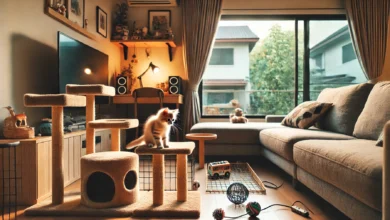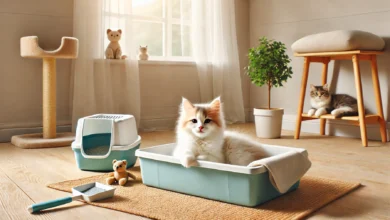Understanding Litter Training Techniques
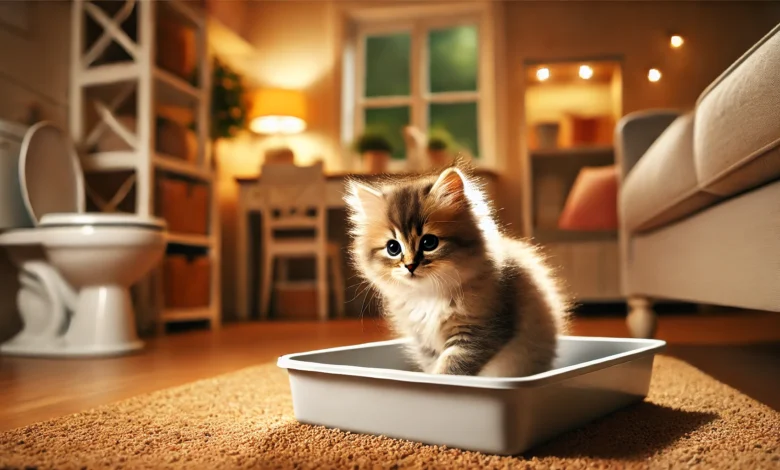
Welcoming a new kitten into your home can be an exhilarating experience, but it also entails great responsibilities.
The most crucial part in raising a healthy and cheerful kitten is teaching them litter training.
Litter training keeps your house clean and also makes your kitten comfortable and confident in their new environment.
In this article, we will be telling you all about the technique of litter training, from choosing a litter box to solving some common challenges that might appear.
If you are a new cat owner or just looking for some helpful tips on how to improve your kitten’s litter box behavior, you’ve come to the right place!
Table of Contents
What is Litter Training and Why is it Important?
Litter training means teaching your kitten to go in a box filled with litter when they have to relieve themselves.
It’s an important behavior that every indoor cat needs to learn to keep your home clean, fresh, and free of accidents.
Your kitten will instinctively know they want to cover their waste; thus, given the proper approach, litter training should not be very difficult.
But why is litter training so important?
First of all, it encourages good hygiene both for your kitten and your household.
A well-trained kitten won’t use any inappropriate area of your home as a bathroom; this will save you from having to clean all the time and protect your floors, furniture, and all the other things from possible damage.
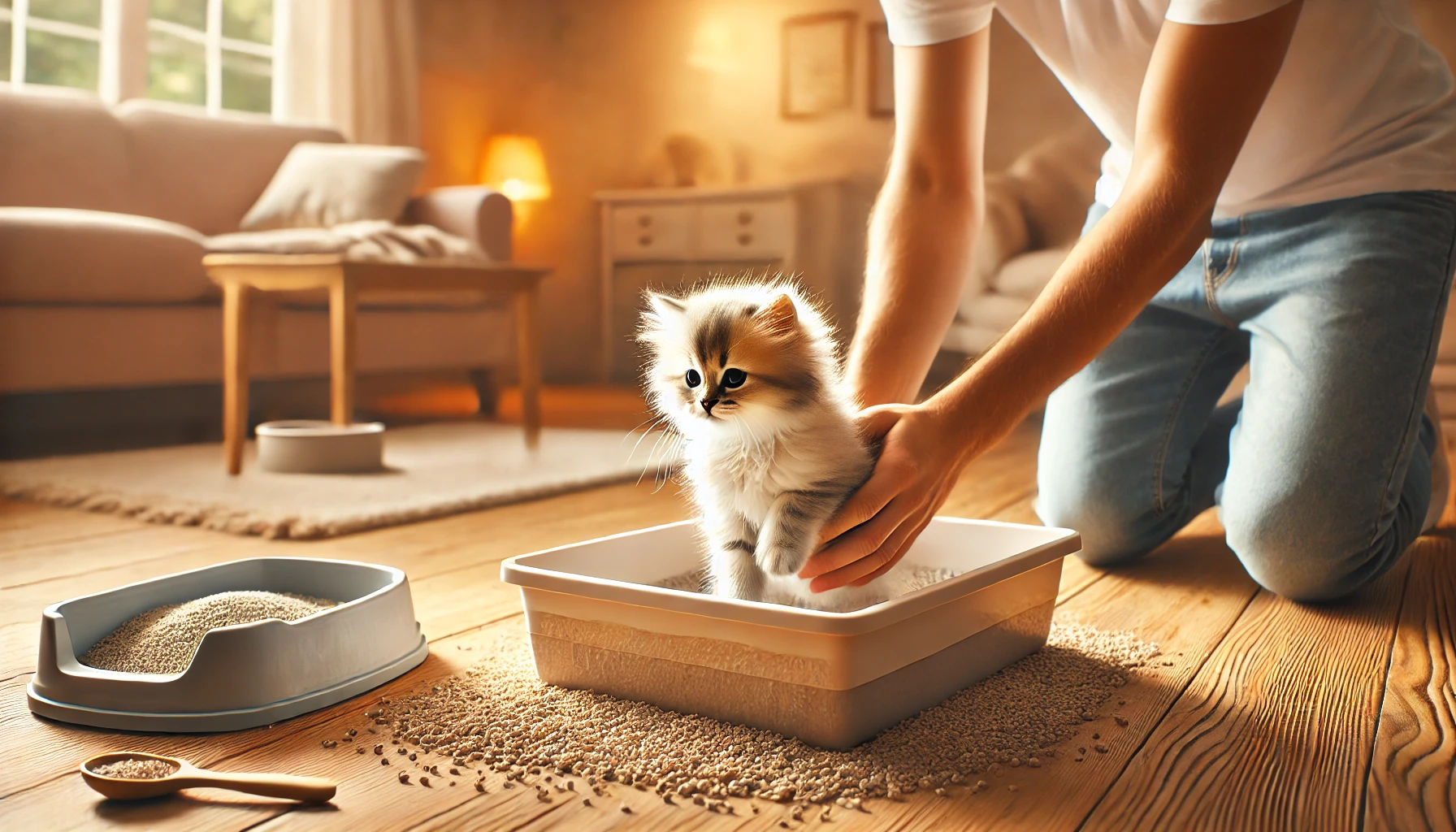
The Basics of Litter Training
Litter training should start right away once you bring your new kitten home.
They need to be introduced to the litter box so they can learn to go there when nature calls.
Place your kitten in the litter box after a meal or after they wake up from their nap, since this is usually the time a kitten will need to go.
Put the litter box in a quiet, easy-to-get-to location where your kitten feels comfortable.
Avoid placing it near their food and water, as cats like to have separate zones for eating and using the bathroom.
A shallow box with low sides can help your kitten easily get in and out, especially if they are tiny.
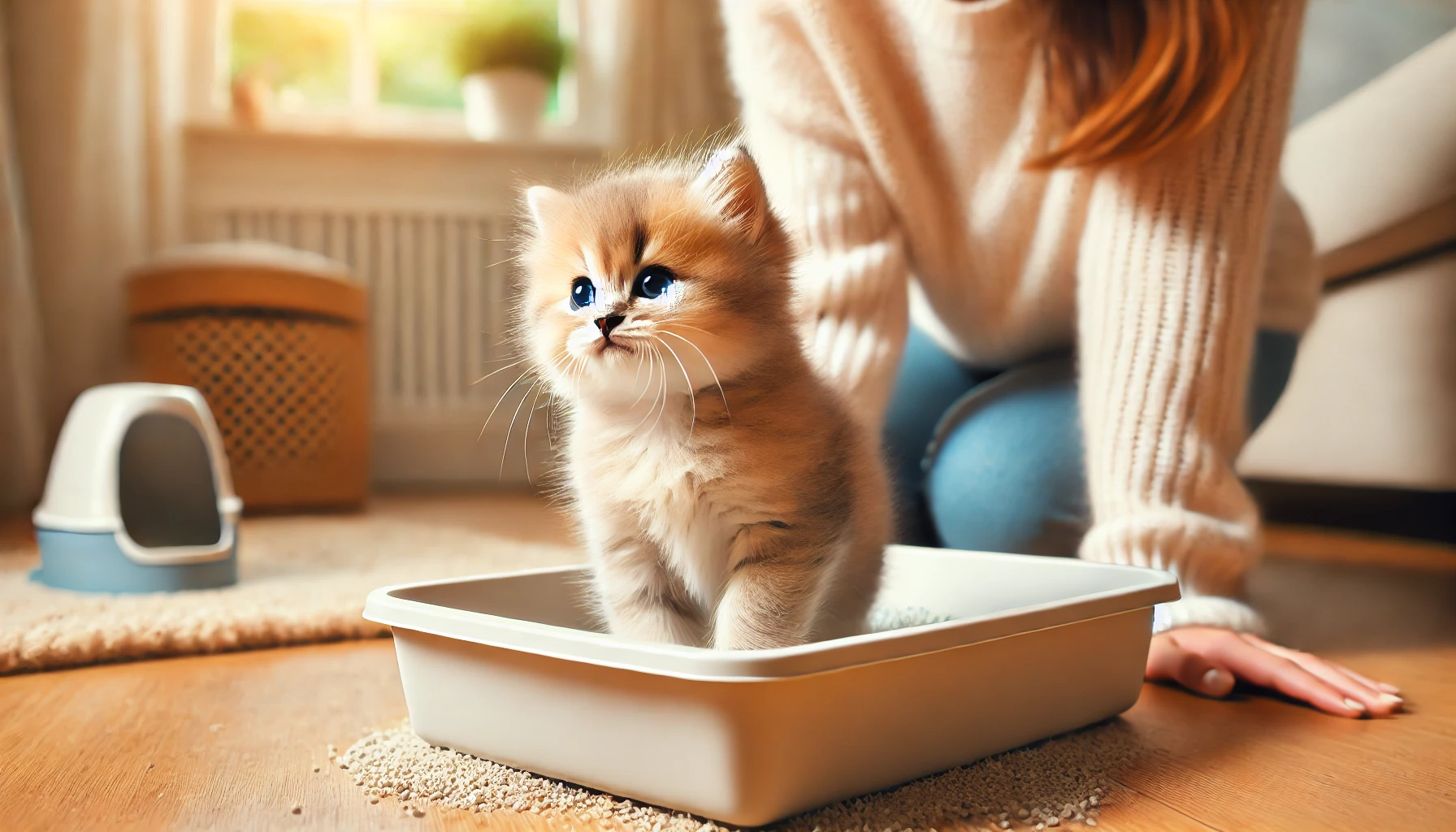
Why Start Litter Training Early?
Starting litter training early sets your kitten up for long-term success.
Kittens are highly impressionable in their early weeks of life, so the sooner good behaviors are instilled, the easier it is for them to settle in and learn.
This also ensures bad habits, like urinating or defecating outside their litter box, do not form, as these behaviors can be difficult to break later.
Additionally, early litter training helps build your kitten’s confidence.
When they know exactly where to go, they are bound to feel less stressed.
This is especially important when they are transitioning to a new home or environment.
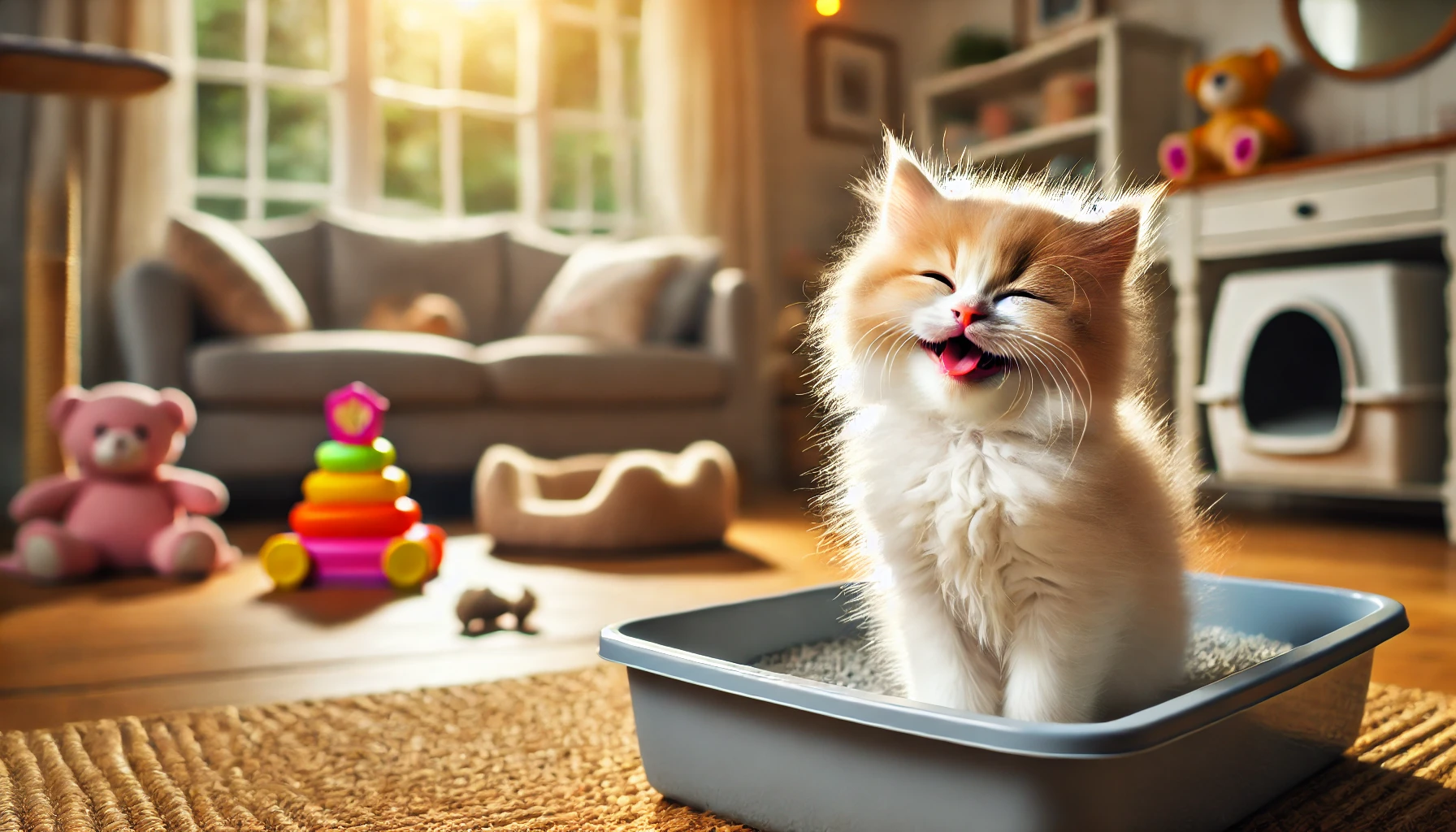
Benefits of Litter Training for Kittens
The benefits of litter training go beyond convenience for the owner; it brings hygiene and reduces stress for the animal.
A well-trained kitten is more content, less anxious, and more adaptable.
When they know where to go, confusion and frustration are eliminated, making for a happier pet.
- Hygiene: Regular use of the litter box helps your kitten stay clean and avoid soiling their fur.
- Stress Reduction: Knowing exactly where to go minimizes anxiety, especially in new environments.
- Strengthens Bond: Successful training strengthens the bond between you and your kitten, as it shows you’re providing a structured, safe space for them.

Common Misconceptions About Litter Training
Many people believe that litter training is either a complicated process or one that takes a lot of time and effort.
However, this is usually not the case.
Since kittens have an instinct to cover up after relieving themselves, litter training can be relatively simple with consistency and patience.
Another common misconception is that some kittens simply cannot be trained.
While medical or behavioral issues may require special attention, most kittens can become well-trained to use the litter box with the right attitude and environment.
Litter training is essential for maintaining a clean home and providing your kitten with confidence in their environment. With proper litter training, both you and your kitten benefit from improved hygiene and reduced stress.
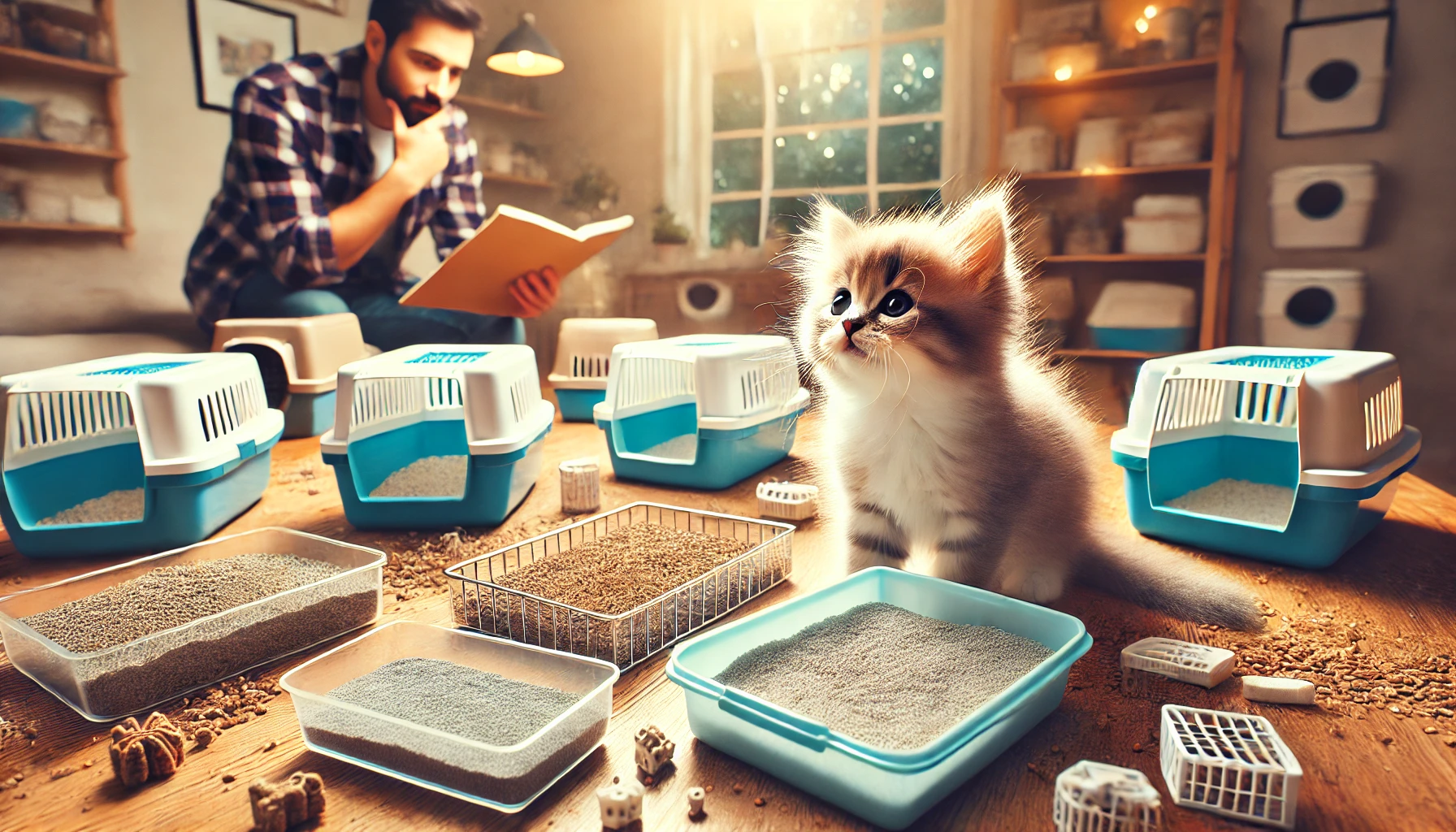
Choosing the Correct Litter and Size of Litter Box
One of the most important decisions you make when litter training is the type of litter and size of the litter box to use.
After all, it’s all about your kitten’s comfort and the cleanliness of your home.
While there are several types to choose from, it’s invaluable to learn what works best for your kitten and your household environment.
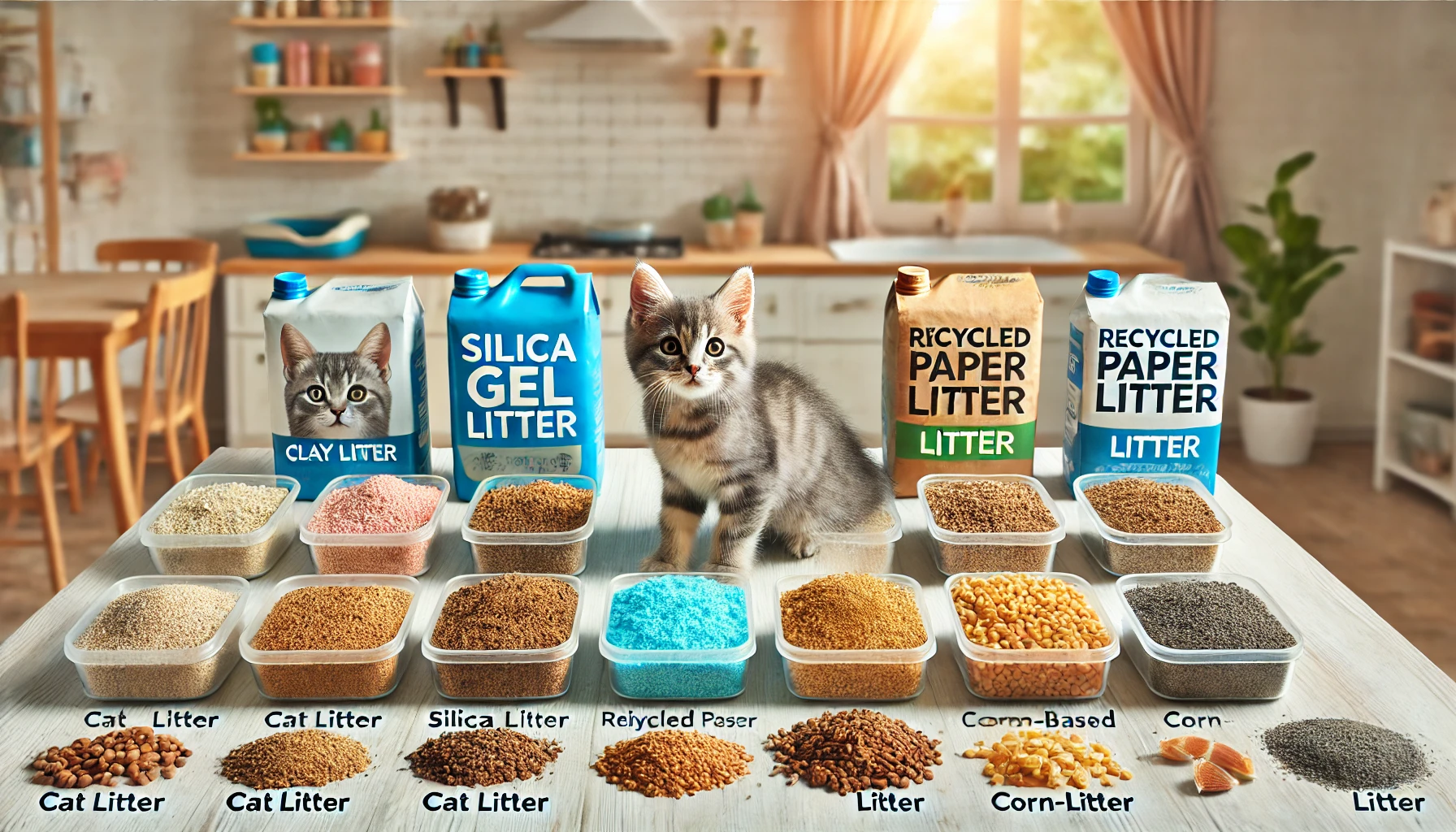
Types of Cat Litter Explained
There are a lot of types of cat litter, each with its pros and cons.
The right choice will depend on your kitten’s preferences, any allergy problems they may have, or the specific needs of your household.
The most common types of litter available on the market are:
- Clay Litter: One of the most common choices, clay litter comes in clumping or non-clumping forms. It is highly absorbent and effective at odor control, though it can be dusty and heavier than other options.
- Silica Gel Litter: Made from silica crystals, this litter is excellent at odor control and less dusty than clay. It is usually more expensive, but it lasts longer, making it a good choice for those who prefer less frequent cleaning.
- Pine or Wood Pellet Litter: A more natural and eco-friendly option, wood pellets are made from recycled materials. They dissolve into sawdust when wet. Though highly absorbent, they may need to be changed more frequently.
- Recycled Paper Litter: This litter is made from recycled paper products and is ideal for kittens with respiratory issues or allergies. It is lightweight and dust-free but may not be as effective at odor control.
- Corn or Wheat-Based Litter: Biodegradable and flushable, these litters are made from natural grains. They are a great choice for environmentally conscious pet owners, although some cats may dislike the texture.

How to Choose the Perfect Litter Box
The litter box itself is just as important as the litter you use inside it.
Your kitten needs a comfortable and easily accessible box to encourage consistent use.
Here are some things to consider when picking out a litter box:
- Size: Kittens need a smaller box with low sides to make it easier for them to climb in and out. As your kitten grows, you will want to upgrade to a larger box so they have room to move around comfortably.
- Covered vs. Uncovered: Some cats prefer the privacy of a covered litter box, while others may feel trapped or claustrophobic in an enclosed space. Pay attention to your kitten’s behavior to determine which option works best for them.
- Material: Most litter boxes are made from plastic, which is easy to clean and durable. Make sure to clean the litter box regularly to prevent odors and maintain hygiene.
- Number of Boxes: If you have more than one cat, it is recommended to have multiple litter boxes—ideally one per cat, plus an extra, to avoid competition and ensure cleanliness.
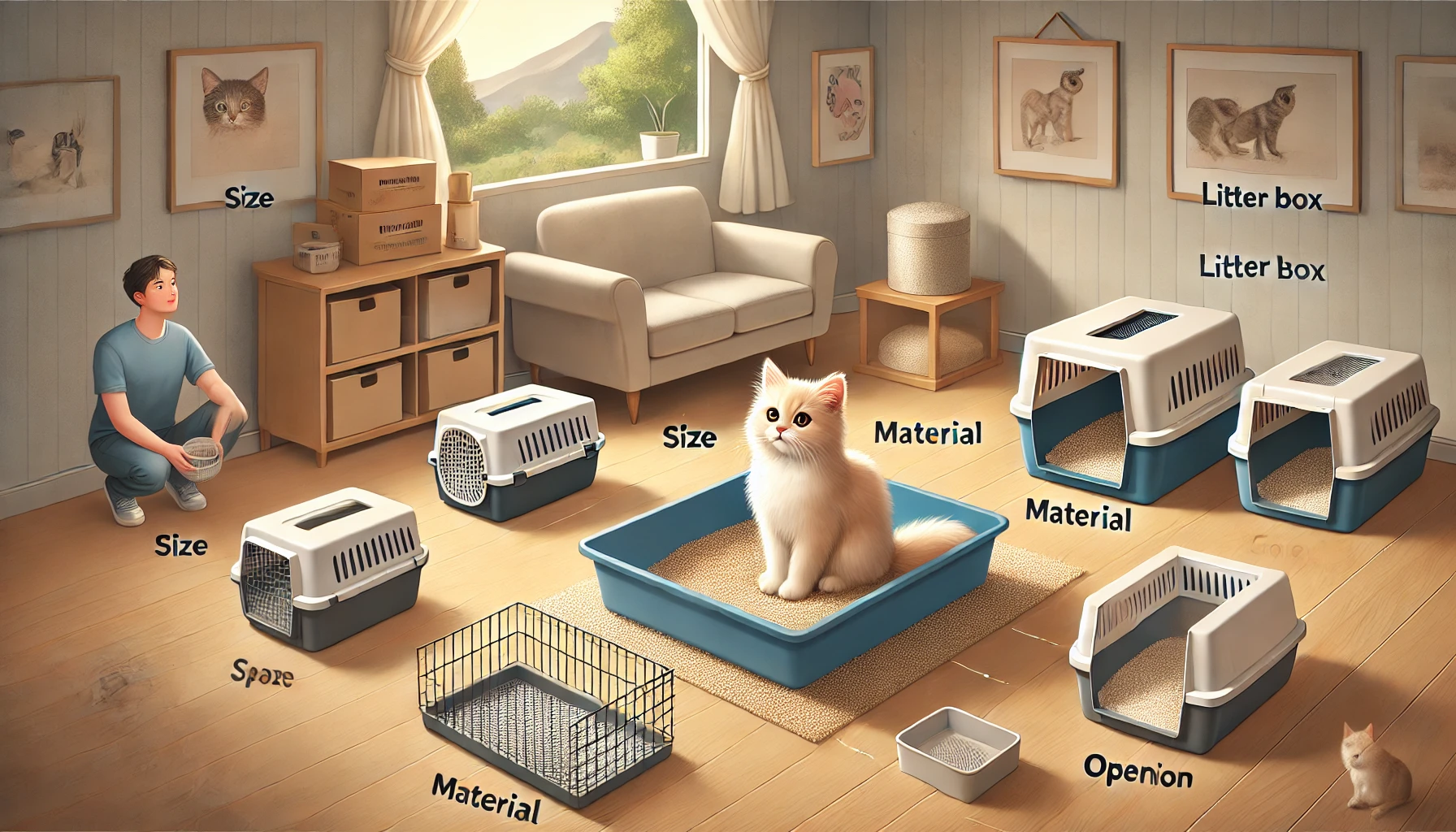
Factors to Consider: Size, Material, and Location
Location is everything when it comes to setting up a litter box.
Place the box in a quiet, low-traffic area where your kitten feels safe and comfortable.
Avoid placing the litter box near noisy appliances or in busy hallways.
The box should also be easy for your kitten to reach at all times.
In addition, the litter box should be large enough for your kitten to turn around and dig comfortably.
As mentioned earlier, when starting with kittens, a small box is suitable, but you should upgrade as they grow.
The size or location of the box might be the reason behind your kitten’s avoidance, so these factors are important to consider.
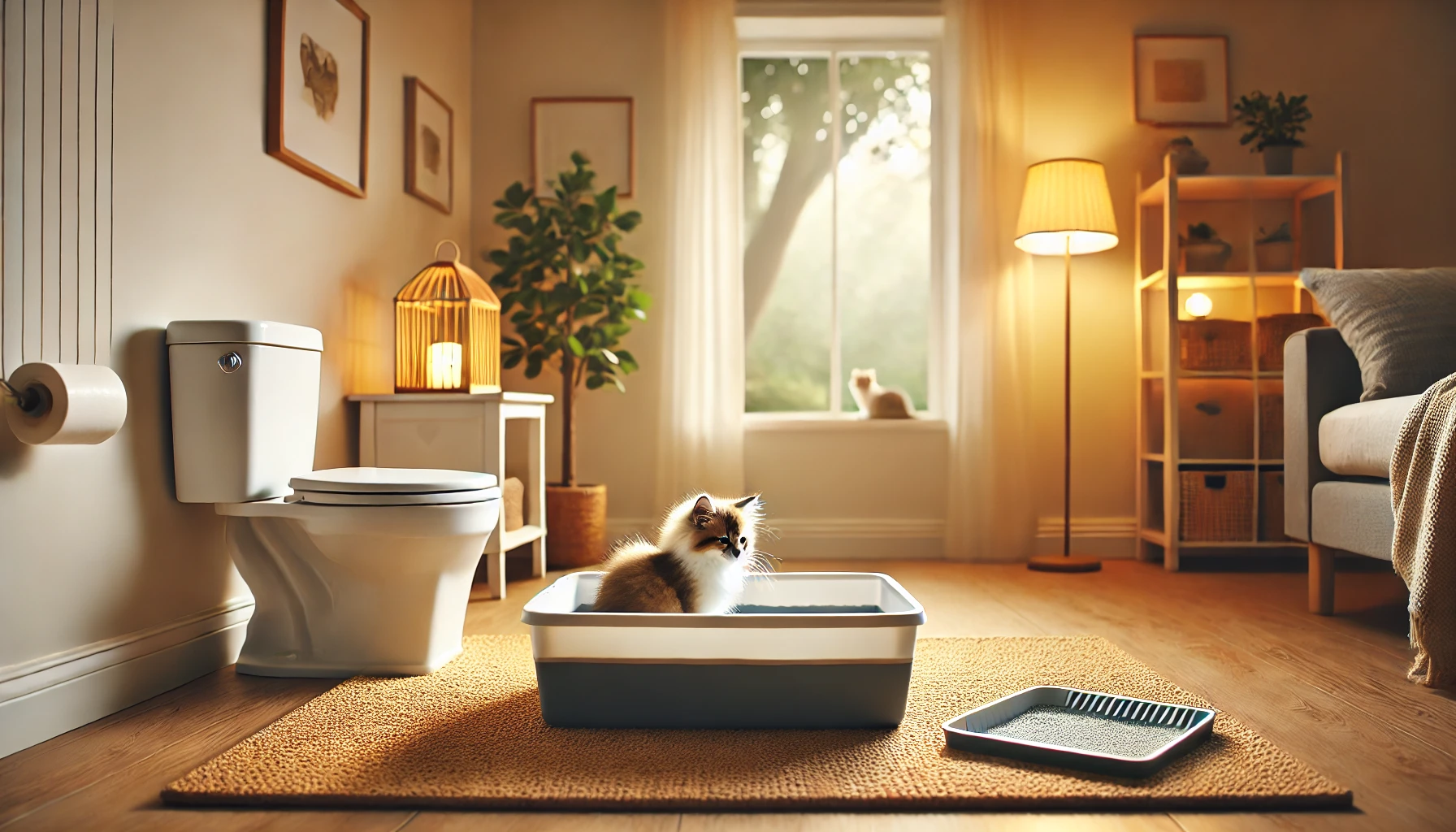
Cleanliness and Comfort
A clean litter box is essential for successful litter training.
Kittens are naturally clean creatures, so if the litter box is dirty, they may stop using it altogether.
Scoop the box daily and replace the litter as needed to keep it fresh and free of odors.
Deep cleaning the box at least once a week using mild soap and water is a good way to maintain cleanliness.
Additionally, placing a litter mat near the box can help catch litter, preventing it from being tracked throughout your home.
This helps keep the area clean while ensuring your kitten associates the space with using the bathroom.
Selecting the right litter and box size ensures your kitten’s comfort. Pay attention to their preferences, health, and environmental needs when making your choice.
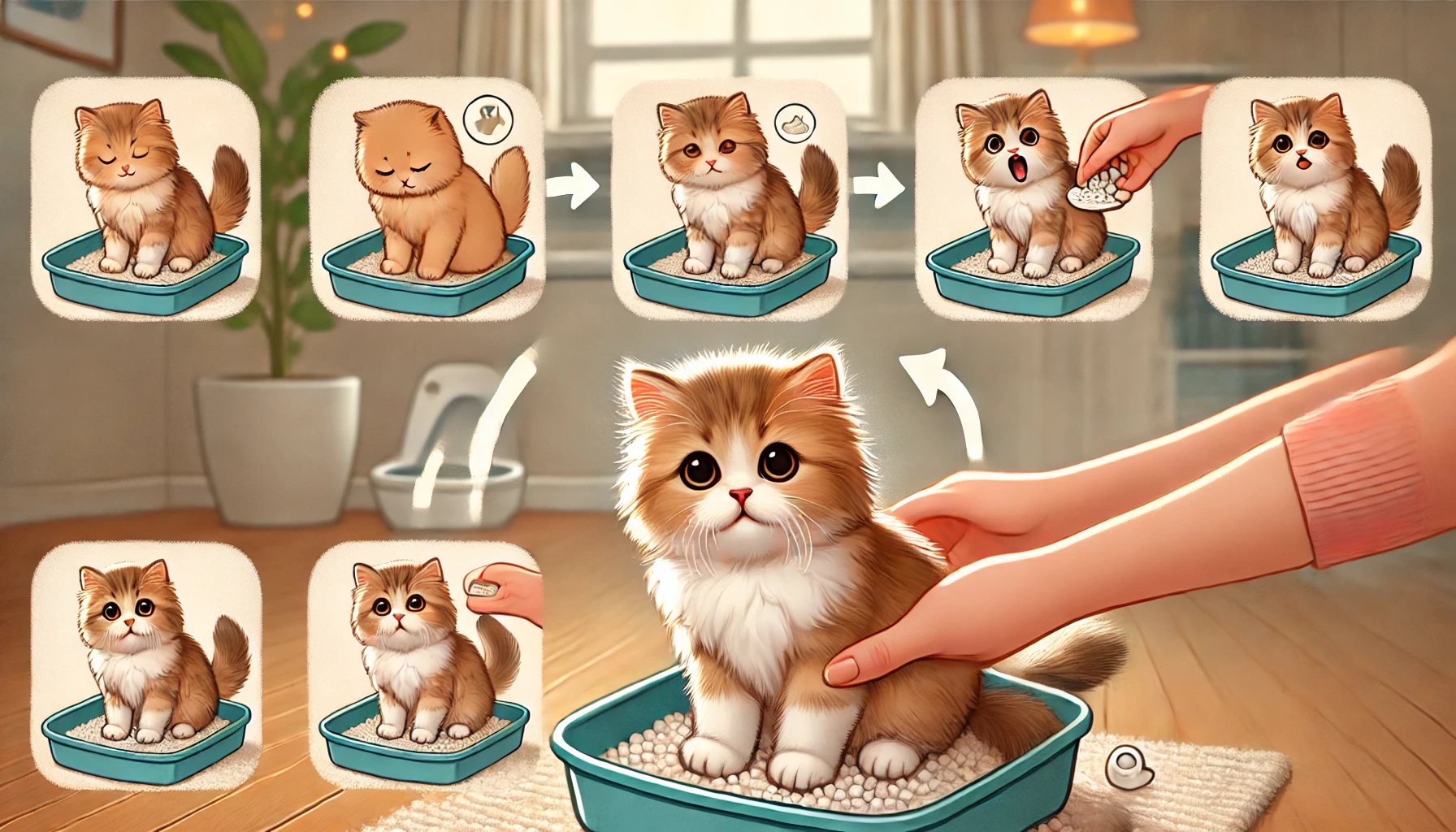
Litter Training Your Kitten in Easy Steps
Consistency and patience are key to successful litter training.
This will ensure that your kitten learns to use the litter box without much trouble through a step-by-step process.
Although kittens instinctively try to cover their droppings, with a little guidance, the transition can be smoother and easier, leading to fewer accidents.
Let’s go step by step to see how you can litter train your kitten effectively.
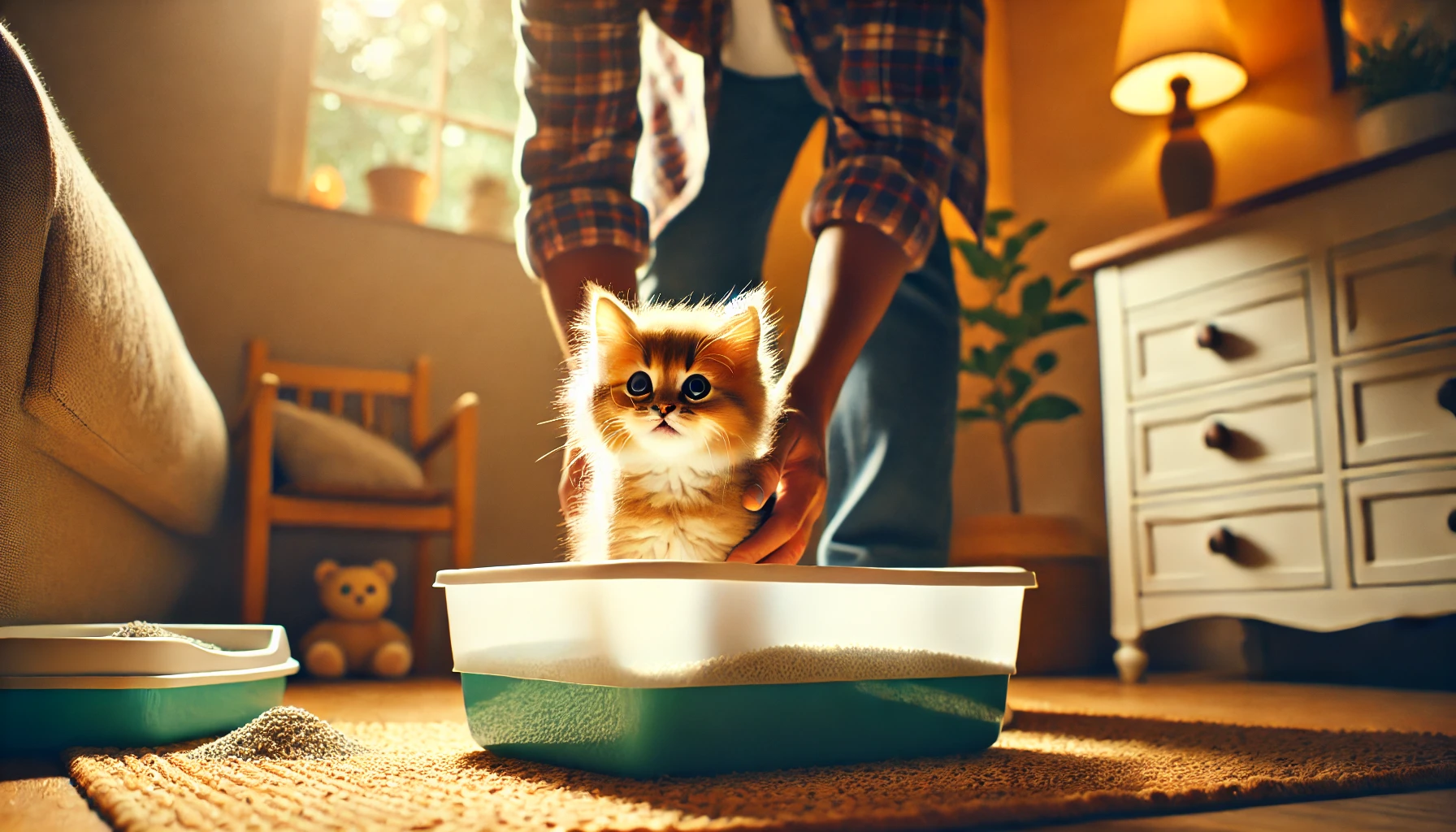
Introducing the Litter Box
The first step in litter training your kitten is introducing them to the litter box.
On the day you bring your kitten home, immediately take them to the litter box and place them inside.
This is especially true after a meal or nap, as these are common times when kittens need to go to the bathroom.
This helps your kitten associate the litter box with the act of going to the bathroom.
Consistency is critical.
Keep the litter box in the same location so your kitten will always know where it is.
Avoid changing the location of the box frequently, as this can confuse your kitten and lead to accidents.

Establishing a Regular Routine
Litter training requires establishing a routine.
Cats thrive on routines, and kittens are no different.
Take your kitten to the litter box at specific times of day—after a meal, when they wake up, or when you notice them sniffing around or circling.
This routine reinforces the habit and teaches your kitten when and where to relieve themselves.
Be patient and allow them to investigate the box.
If your kitten doesn’t immediately use the litter box, don’t panic.
Some kittens take a little longer to get used to the new environment, but with consistency, they will catch on.
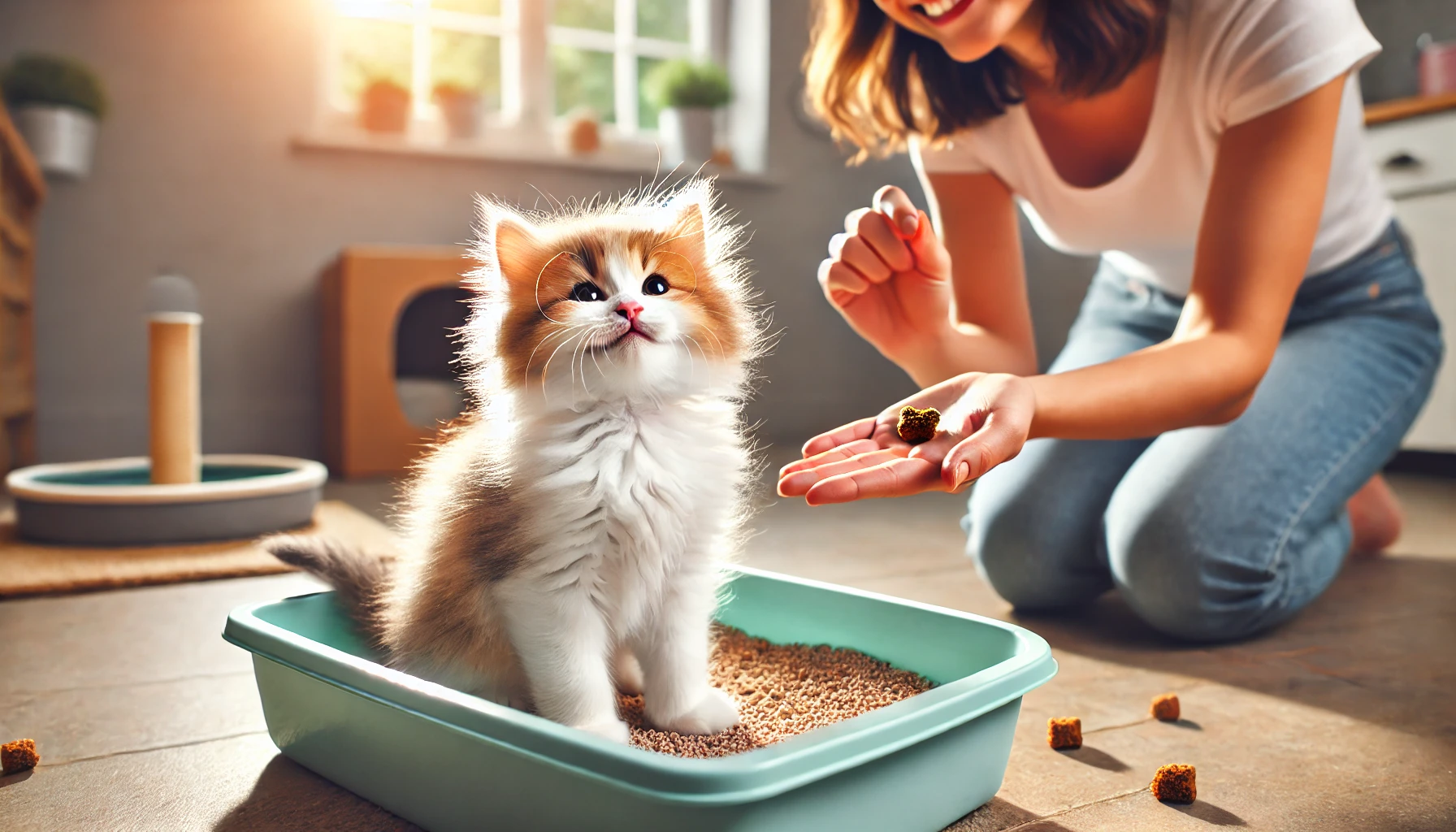
Reinforcing Positive Behavior
Positive reinforcement is one of the best tools for litter training.
Each time your kitten uses the litter box properly, praise them with soft words or petting, signaling that they’ve done well.
Some owners even offer a small treat as a reward, but be cautious not to overdo it, as too many treats can lead to health issues.
Avoid punishing your kitten for accidents.
Negative reinforcement, such as scolding or rubbing their nose in the mess, can make them fearful and confused, worsening the problem.
Instead, clean up the accident and gently guide them back to the litter box to remind them where they should go.

Dealing with Setbacks
Even with the most successful litter training routine, accidents can happen.
Kittens may occasionally have accidents or avoid the litter box.
If this happens, try to determine why.
Is the litter box too dirty?
Is it in a noisy location?
Could there be health issues such as bladder infections or digestive problems?
Addressing these issues can help prevent future accidents.
Keep the litter box clean, scoop it daily, and place it in a quiet, comfortable spot.
If your kitten continues to have accidents despite making these changes, it’s a good idea to consult a veterinarian to rule out any health problems.

When to Seek Help
If you’ve tried different litter training methods and your kitten still isn’t making progress, it may be time to seek help.
Sometimes, behavioral issues or health conditions can interfere with using the litter box.
A visit to the veterinarian can rule out medical problems, such as bladder infections or digestive issues.
In some cases, consulting a professional animal behaviorist may also be helpful.
Behaviorists can assess your kitten’s behavior and provide specific advice to address particular problems.
Don’t be discouraged if your kitten takes a little longer to adjust.
With patience, consistency, and proper guidance, most kittens will learn to use the litter box successfully.
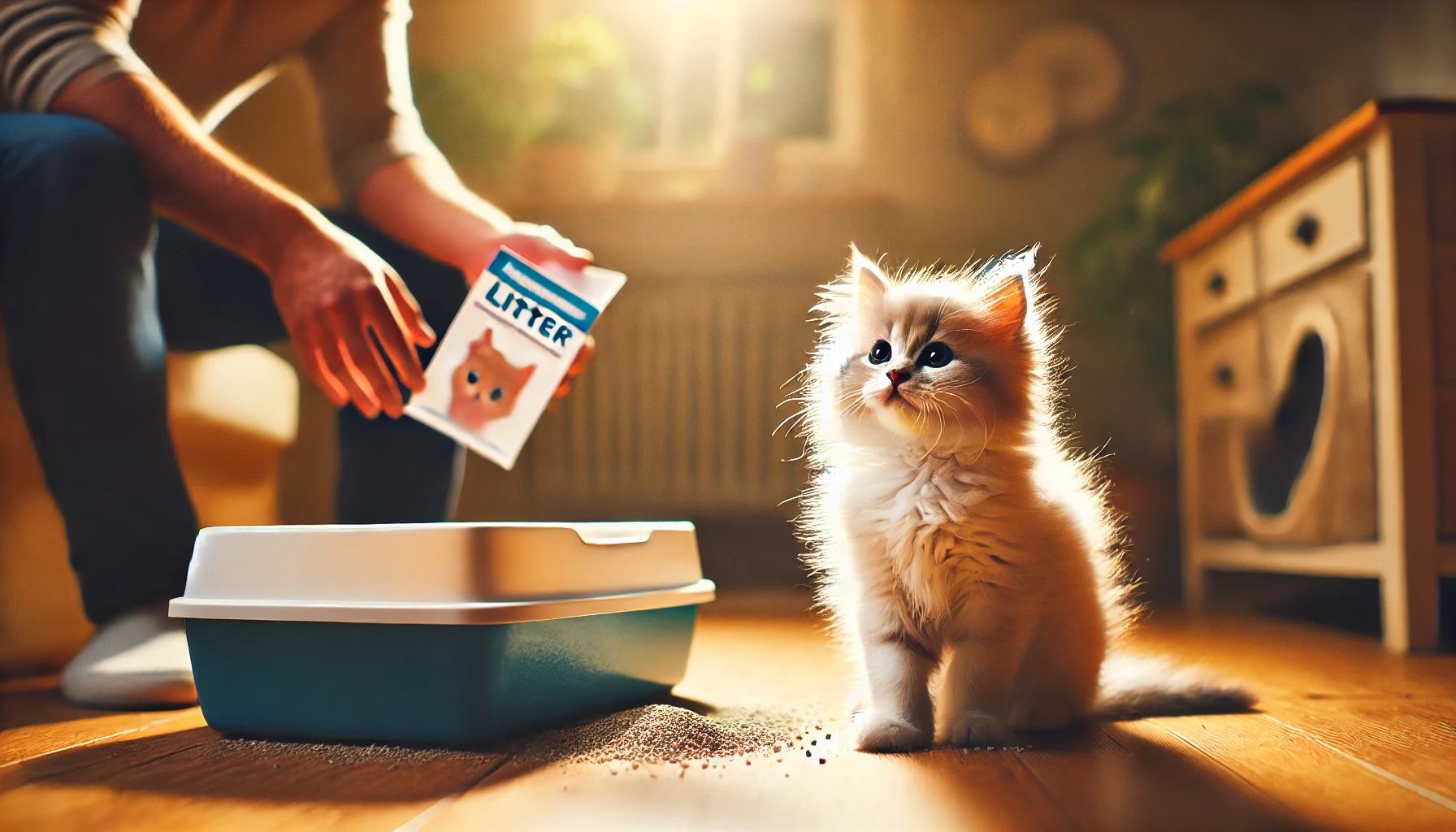
Common Problems with Litter Training and How to Overcome Them
Even with the best litter training practices, you may encounter some challenges along the way.
Kittens can sometimes be quite unpredictable, and different factors may cause them to avoid the litter box.
However, understanding these common issues and knowing how to handle them is key to your kitten’s success.
Let’s look at some common litter training challenges and how to overcome them.
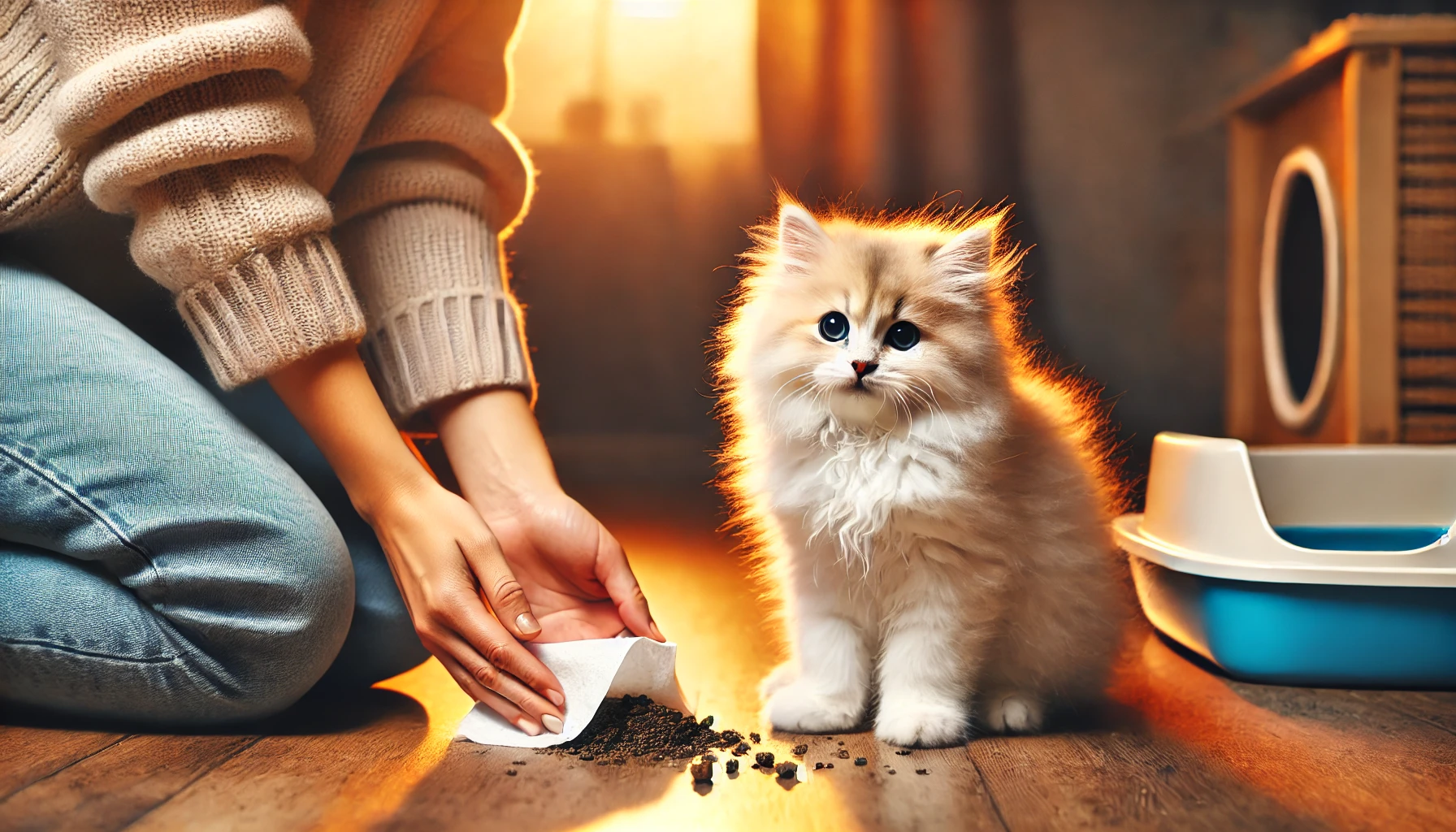
Handling Accidents Outside the Litter Box
One of the most common issues is accidents that kittens have outside the litter box.
This can happen for a variety of reasons, from preferences in litter type to not knowing where the box is located.
Here’s how you can handle these situations:
- Check the Litter Box Location: Make sure the litter box is easily accessible and located in a quiet area. Avoid placing it in spots with loud noises or heavy foot traffic, as these can deter your kitten from using it.
- Keep the Box Clean: Kittens are naturally clean animals. Scoop the litter box daily and change the litter frequently to reduce odors. A dirty box may lead your kitten to relieve themselves elsewhere.
- Choose the Proper Litter: Some kittens may not like certain types of litter. Try switching to a softer or dust-free option to see if your kitten responds better.
- Routine and Consistency: Ensure your kitten follows a regular routine. Take them to the litter box after meals and naps to help establish the habit.
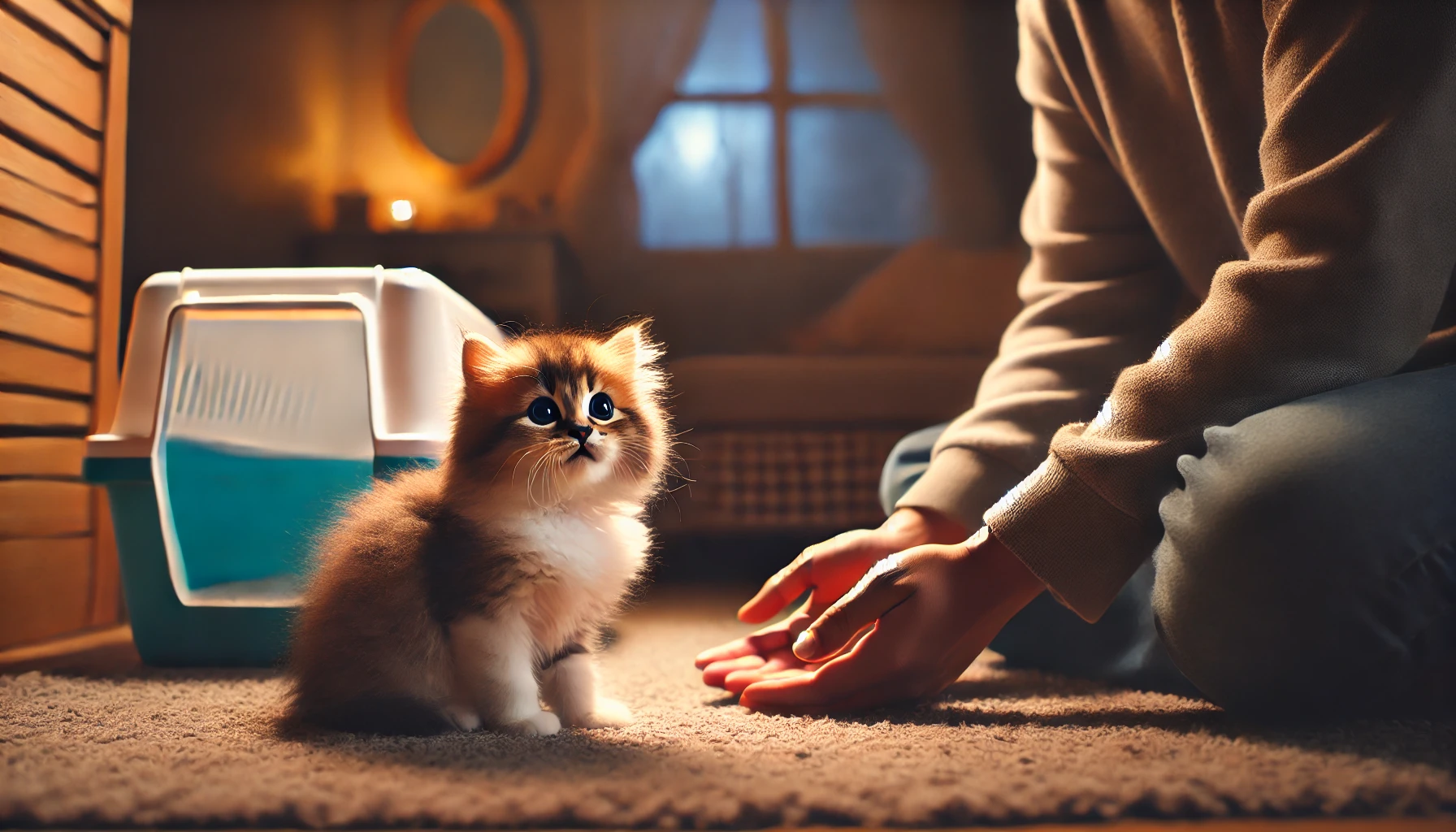
Fear or Anxiety
Anxiety, either medical or behavioral, can sometimes affect a kitten’s willingness to use the litter box.
If your kitten has been startled while using the box or has had a negative experience, they may develop anxiety around it.
Here’s how to address this issue:
- Create a Safe Environment: The litter box should be a quiet and private place. Keep it away from loud appliances or busy areas to ensure your kitten feels safe using it.
- Positive Reinforcement: Praise and reward your kitten immediately after they use the litter box to build positive associations.
- Patience: Give your kitten time to adjust. If they seem anxious or hesitant, introduce them to the litter box gradually without forcing them.
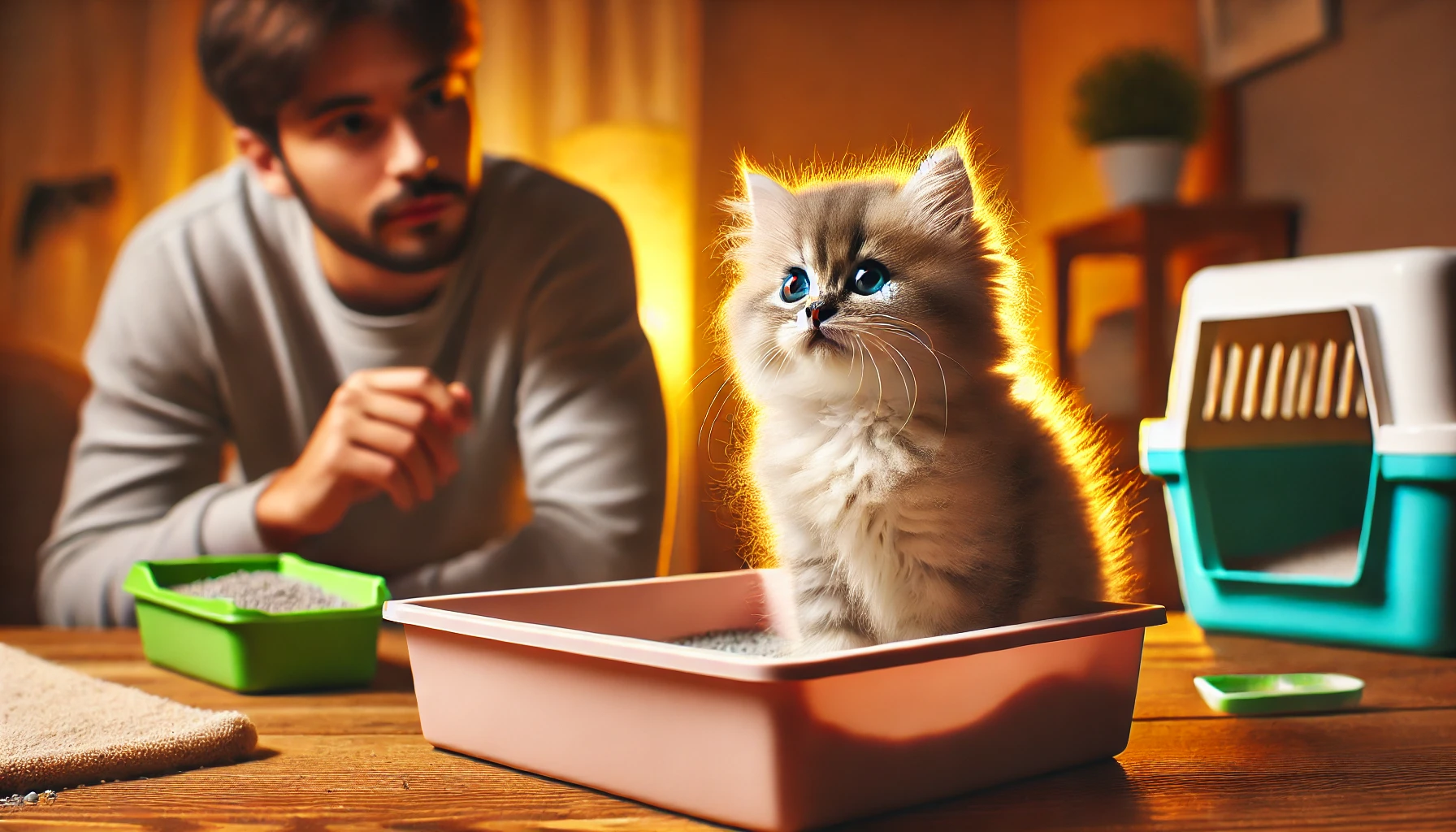
Litter Box Avoidance: Causes and Solutions
Litter box avoidance can be caused by health concerns, stress, or dissatisfaction with the box itself.
If your kitten is refusing to use the litter box, here are some solutions to try:
- Health Concerns: Rule out any health issues, such as urinary tract infections or constipation, with the help of a veterinarian.
- Test the Litter Box: Make sure the litter box is appropriately sized and try different styles, such as covered or uncovered, to find what works best.
- Litter Type: Your kitten may not like the type of litter you are using. Try switching to a softer or unscented option to see if this resolves the issue.
- Location Matters: The location of the litter box is important. Ensure it is placed in a quiet, easily accessible spot.
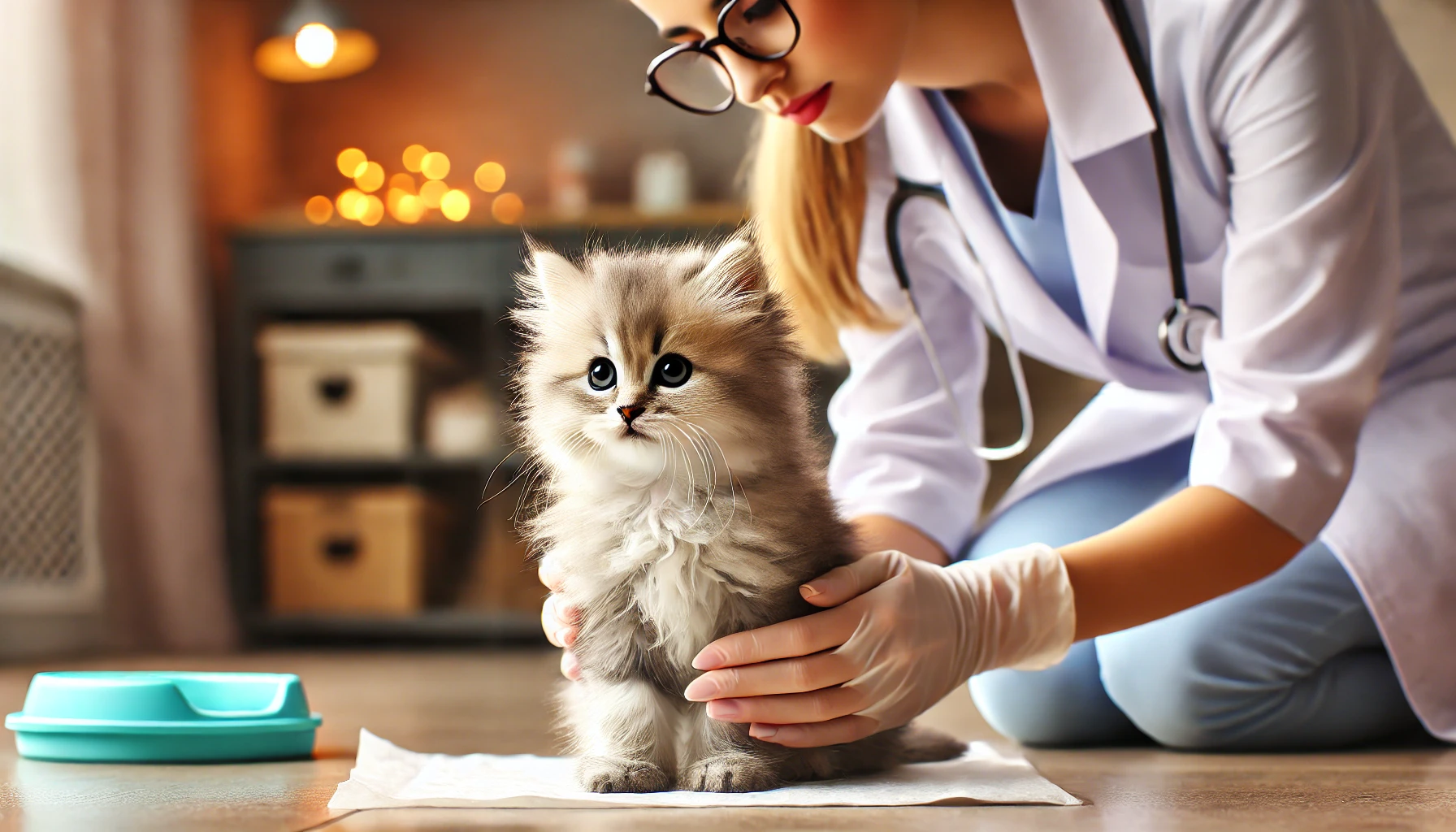
Health Issues That May Impact Litter Training
Sometimes, medical problems can interfere with litter training.
If your kitten suddenly stops using the litter box or starts having frequent accidents, it may indicate a health issue.
Here are some common health problems that can affect litter training:
- Urinary Tract Infections: These can make your kitten uncomfortable, leading them to avoid the litter box. If you notice frequent urination or discomfort, consult a vet.
- Constipation or Diarrhea: Gastrointestinal issues can deter a kitten from using the litter box. Veterinary attention is necessary if you suspect digestive problems.
- Bladder Issues: Bladder inflammation or stones can make urination painful, causing your kitten to avoid the litter box.

Changing Strategies for Aging Cats
While litter training is typically associated with kittens, older cats may also need assistance adjusting to a new litter box or environment.
Aging cats face different challenges, but with a few changes, you can make things easier for them.
Here’s how:
- Ease of Access: Older cats, especially those with mobility issues, need a litter box that is easy to access. Consider a low-sided or ramped box to make entering and exiting easier.
- Comfortable Litter: Older cats may develop sensitivities or arthritis, so softer litter that is gentle on their paws can be more comfortable for them.
- Consistency and Routine: Like kittens, older cats benefit from a consistent routine. Take time to establish a new routine if the litter box or its location changes.
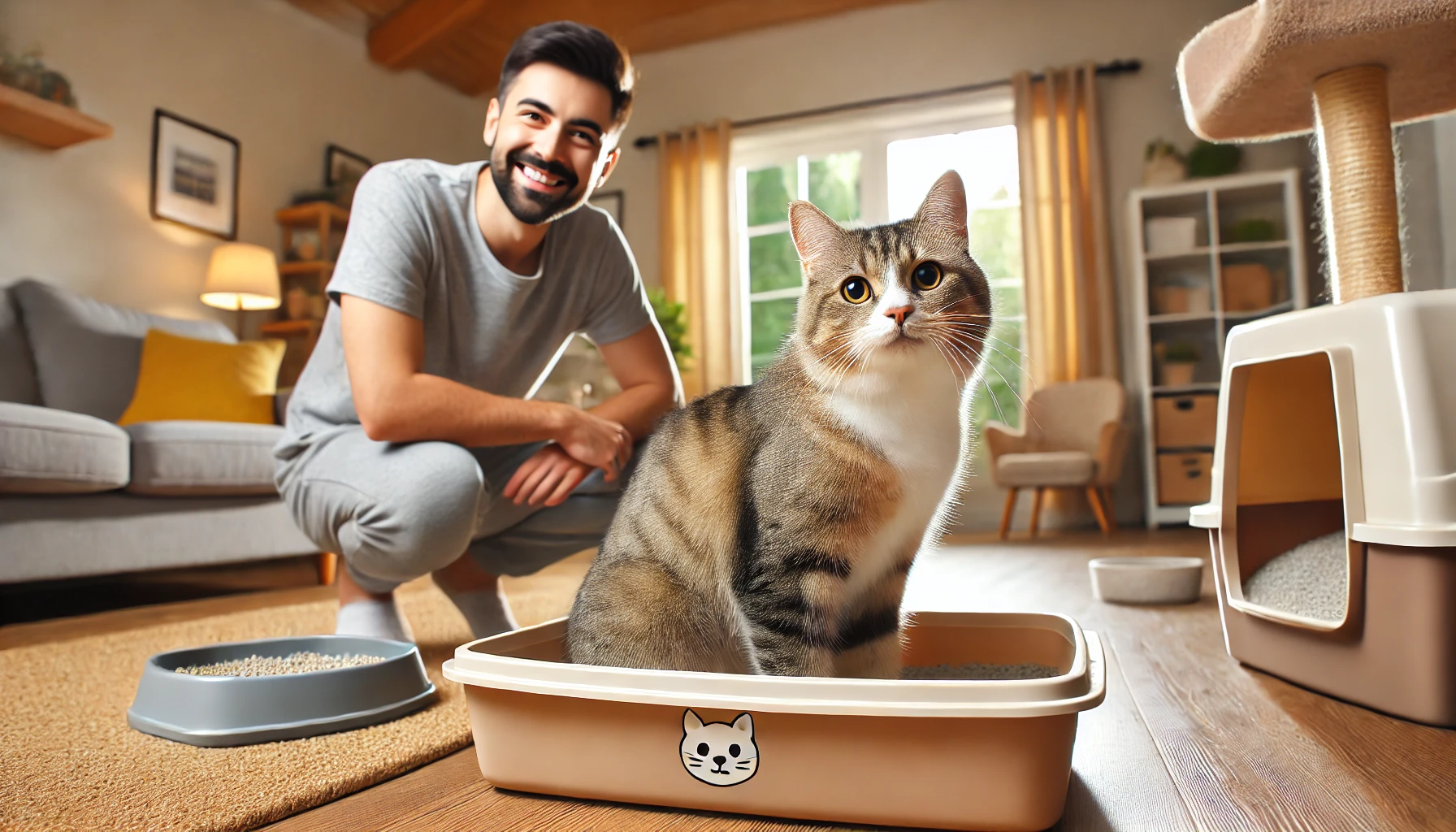
Long-Term Litter Box Success
Once your kitten has reached full litter training success, the key to maintaining long-term success is ensuring that your cat continues to use the litter box as they grow older.
Keeping the litter box clean, monitoring your cat’s habits, and making adjustments when needed will help prevent setbacks.
Here’s how you can maintain long-term litter box success.

Routine Cleaning and Maintenance
A clean litter box is vital for ensuring your cat continues to use it regularly.
Cats are naturally clean animals, so it doesn’t take much for a dirty litter box to become unappealing to them.
Here’s how to keep the litter box clean and inviting:
- Scoop Daily: Scoop out solid waste and clumped litter daily to prevent odors from building up and to keep the box fresh.
- Change Litter Regularly: Change the litter completely once a week, or sooner depending on the type of litter used, to maintain hygiene.
- Deep Clean Weekly: At least once a week, clean the litter box with mild soap and water to remove lingering odors and residue. Avoid using strong chemicals, as their scent can be unpleasant to cats.
- Litter Box Location: Continue monitoring the litter box’s location. It should remain in a quiet, accessible place where your cat can use it without stress.
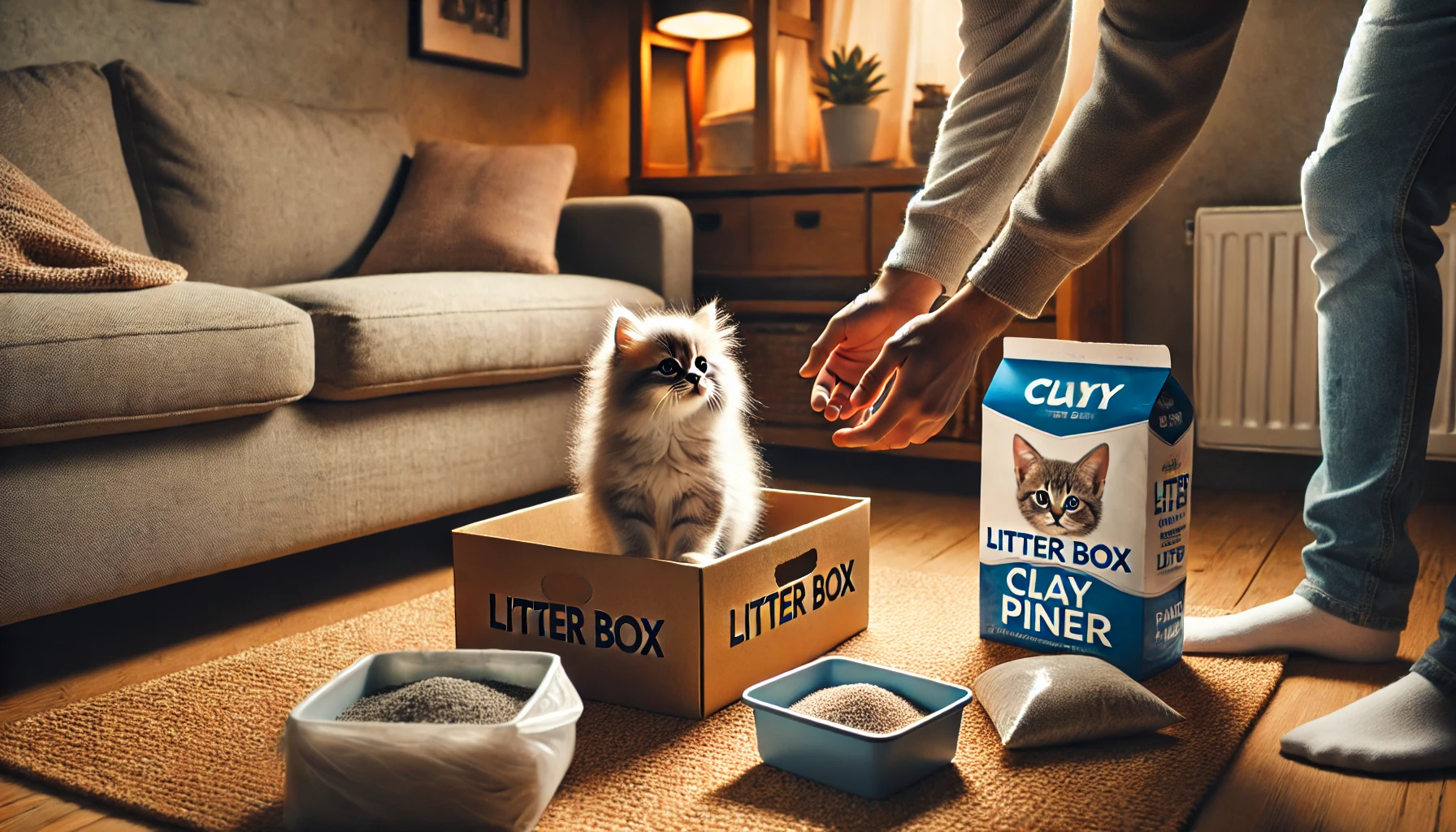
Changing to a New Litter Box or a Different Type of Litter
As your cat grows, or their needs change, you may need to upgrade to a larger litter box or switch to a different type of litter.
Cats are creatures of habit and can be sensitive to changes.
Gradual transitions can help avoid disrupting their litter box habits.
Here are some steps to smoothly transition:
- Introduce Slowly: Place the new litter box or litter type next to the older one, and allow your cat to become familiar with it at their own pace. Let them take their time to explore.
- Mix Types: If switching to a new type of litter, mix the old litter with the new over several days. Gradually increase the new litter while reducing the old.
- Monitor Behavior: Watch for signs of discomfort or avoidance as your cat gets used to the new litter or box. If they act hesitant, give them more time to adapt before making a complete switch.
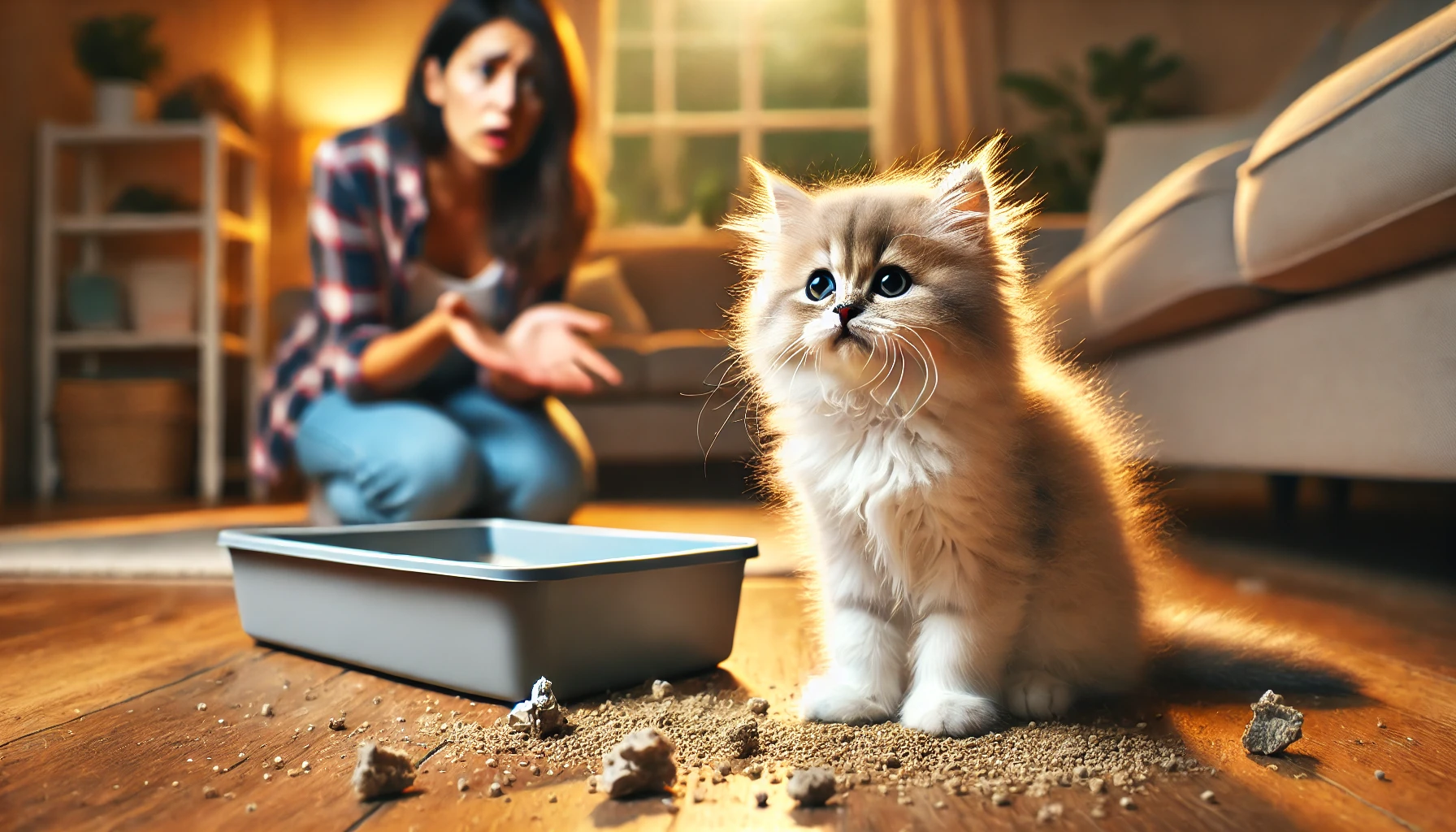
Signs of Litter Box Problems
Changes in your cat’s behavior can sometimes indicate an issue with the litter box.
Recognizing these early warning signs can help you identify and resolve problems before they become serious.
Common signs of litter box issues include:
- Urination Outside the Box: If your cat starts urinating outside the litter box, it could be a sign that the box isn’t clean enough, is in an undesirable location, or that your cat is experiencing medical issues such as a urinary tract infection.
- Excessive Scratching or Digging: Excessive scratching in the litter box may indicate that your cat doesn’t like the type of litter or that the box needs cleaning.
- Avoidance: Avoiding the litter box altogether could signal a problem with cleanliness, location, or size. Consider each of these factors and make necessary adjustments.
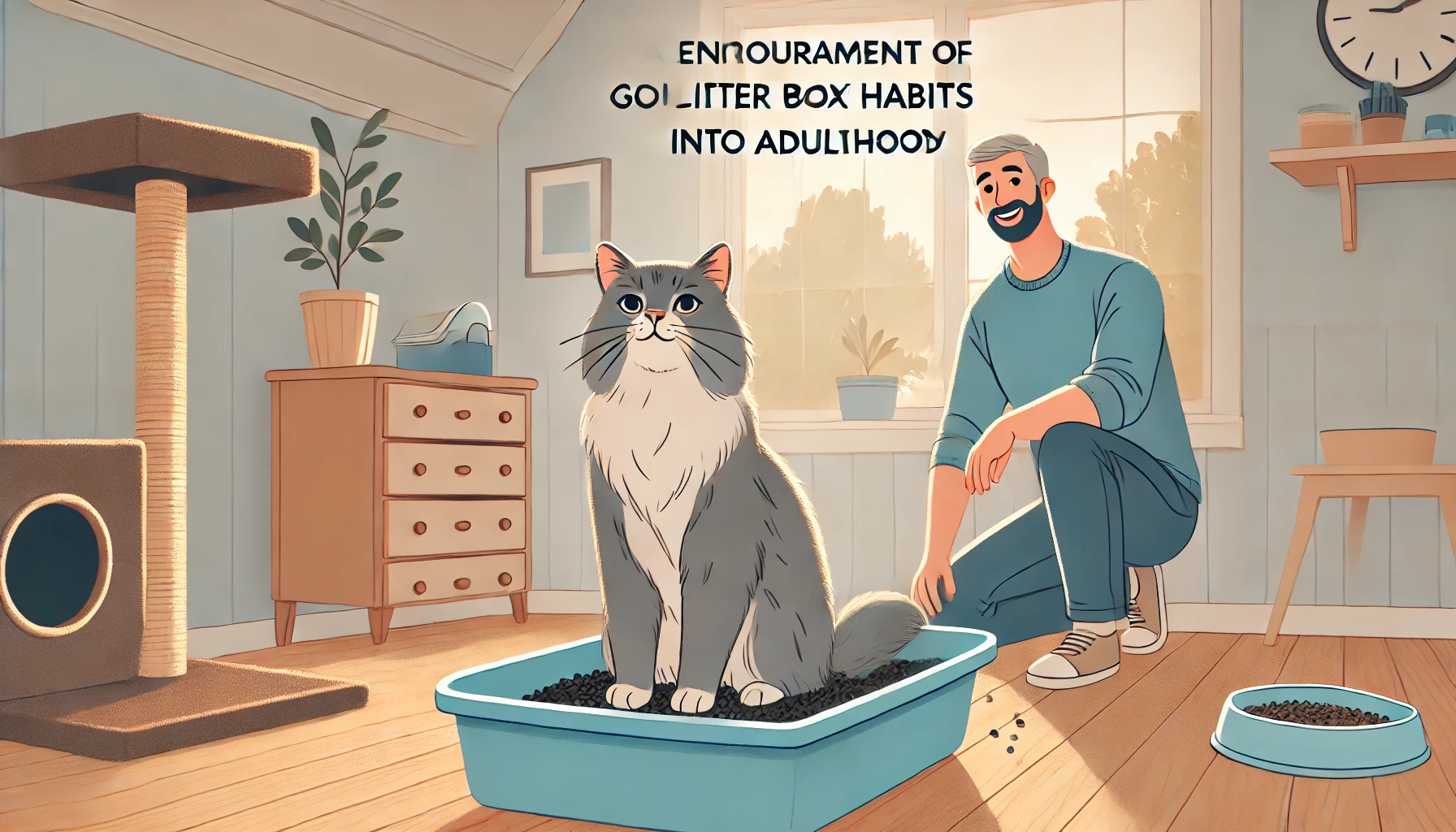
Encouraging Good Habits into Adulthood
Maintaining litter training success into adulthood requires consistent habits and a comfortable environment.
Here’s how you can promote good litter box habits as your cat ages:
- Maintain a Schedule: Stick to the same feeding schedule and bathroom breaks to reinforce good habits. Cats thrive on routine, and consistency helps them maintain positive behavior.
- Watch for Health Problems: As cats age, they may develop health issues that can affect their litter box habits. Keep an eye on changes in behavior and consult a vet if needed.
- Provide a Comfortable Space: Ensure the litter box is placed in a quiet, accessible location where your cat feels safe and comfortable using it.
By keeping litter boxes clean, maintaining routines, and providing a comfortable space, you can ensure that your cat continues to use the litter box successfully throughout their life.

Mastery of Litter Training: The Key to Long-Term Success
Successful litter training of a kitten is essential to maintaining a peaceful home environment with a happy, confident cat.
Patience, consistency, and attention to your kitten’s needs are the key tools for laying a foundation of good, lifelong habits.
This article has covered the major aspects of litter training, from choosing the right litter and box to overcoming common challenges throughout the process.
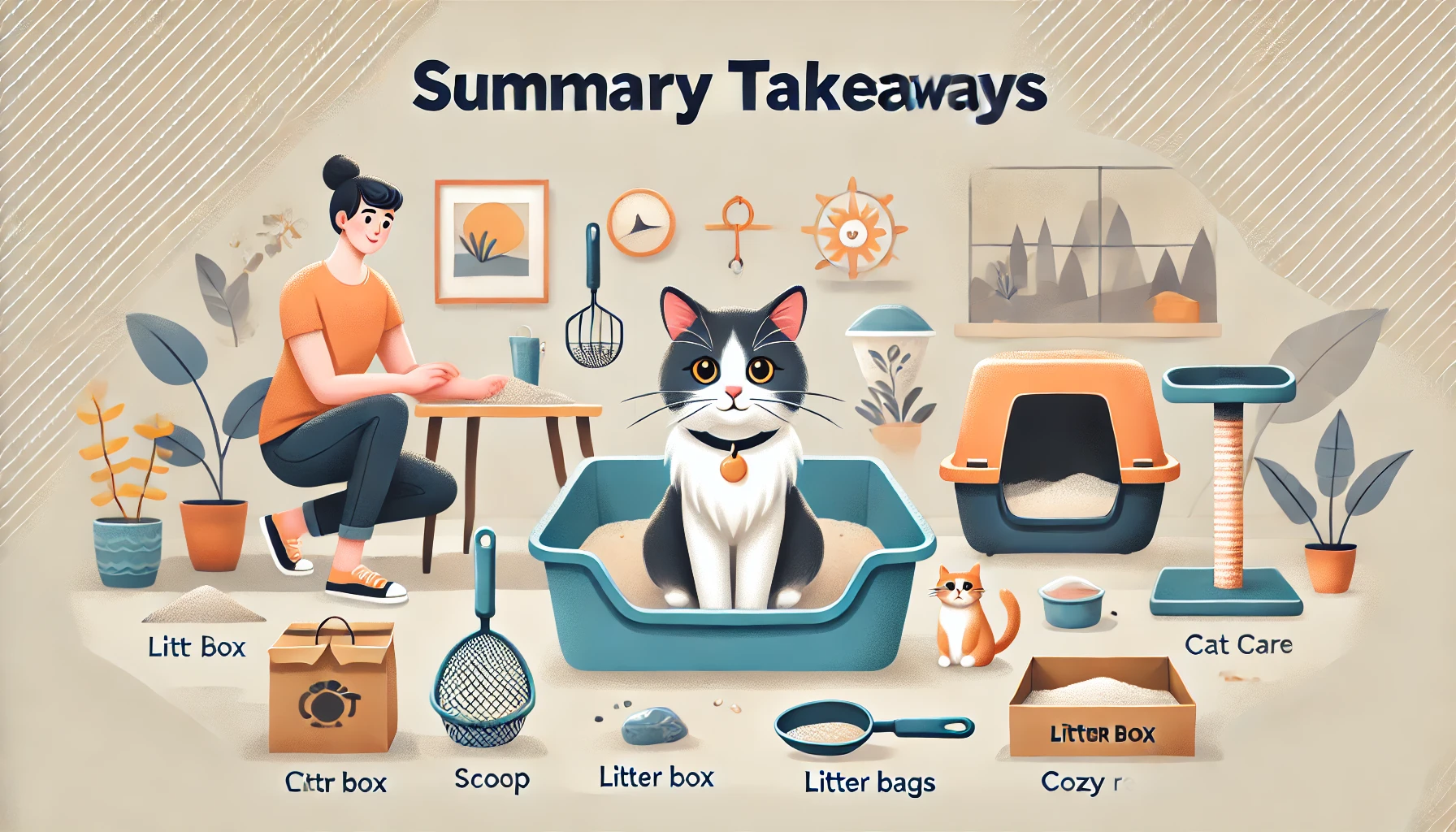
Training Your Cat: Litter Training Key Takeaways
The key to successful litter training is understanding the basics and paying close attention to your kitten’s individual preferences.
Here’s a quick rundown of what you need to know:
- Start Early: Begin litter training as soon as your kitten comes home to establish excellent behavior from day one.
- Consistency is Key: Place the litter box in a quiet, accessible location and try not to move it around too much.
- Use Positive Reinforcement: Reinforce good behavior by praising your kitten when they use the box correctly.
- Maintain Hygiene: Scoop the litter box daily and change the litter regularly to keep the area clean and pleasant for your cat.
- Monitor for Health Issues: If your kitten suddenly stops using the litter box, it could be a sign of health problems, so visit a veterinarian when needed.
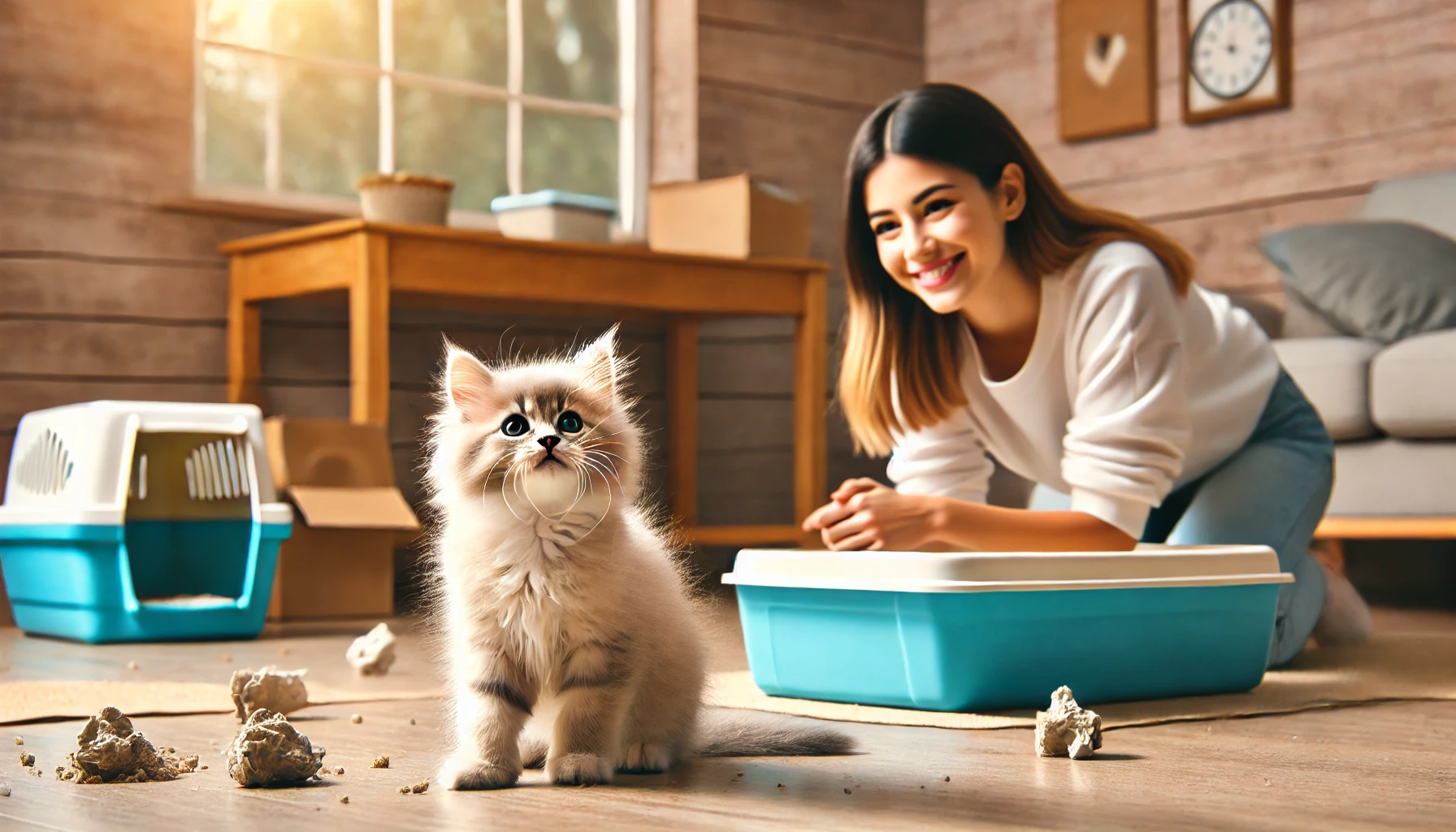
Overcoming Challenges with Litter Training
Even with the best-laid plans, challenges can arise, but most litter training issues can be resolved with the proper approach.
Whether your kitten has accidents outside the box or seems anxious about using it, the key is patience and modifying your approach based on their behavior.
Ensure the litter box is in a quiet, secure location, and try switching the litter type or box style if your kitten seems uncomfortable.
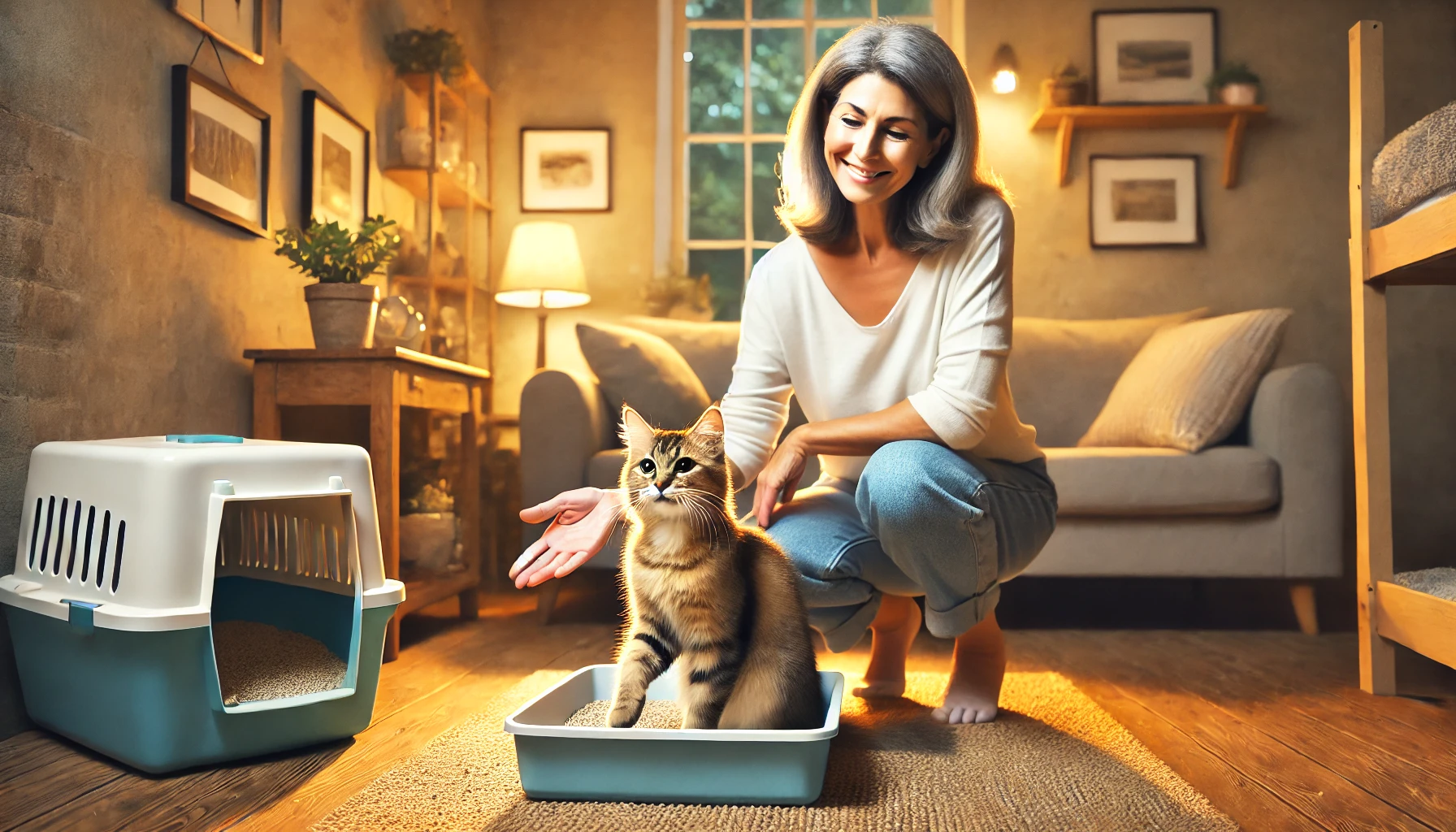
Litter Training into Adulthood
As your kitten matures, maintaining a clean and comfortable litter box is crucial.
Cats are creatures of routine, so sticking to a consistent feeding schedule and maintaining regular bathroom times will ensure long-term litter box success.
Keep an eye on any changes in your cat’s behavior, as avoidance of the litter box could signal health problems.
By creating a comfortable environment for your cat, you’re fostering lifelong good habits.
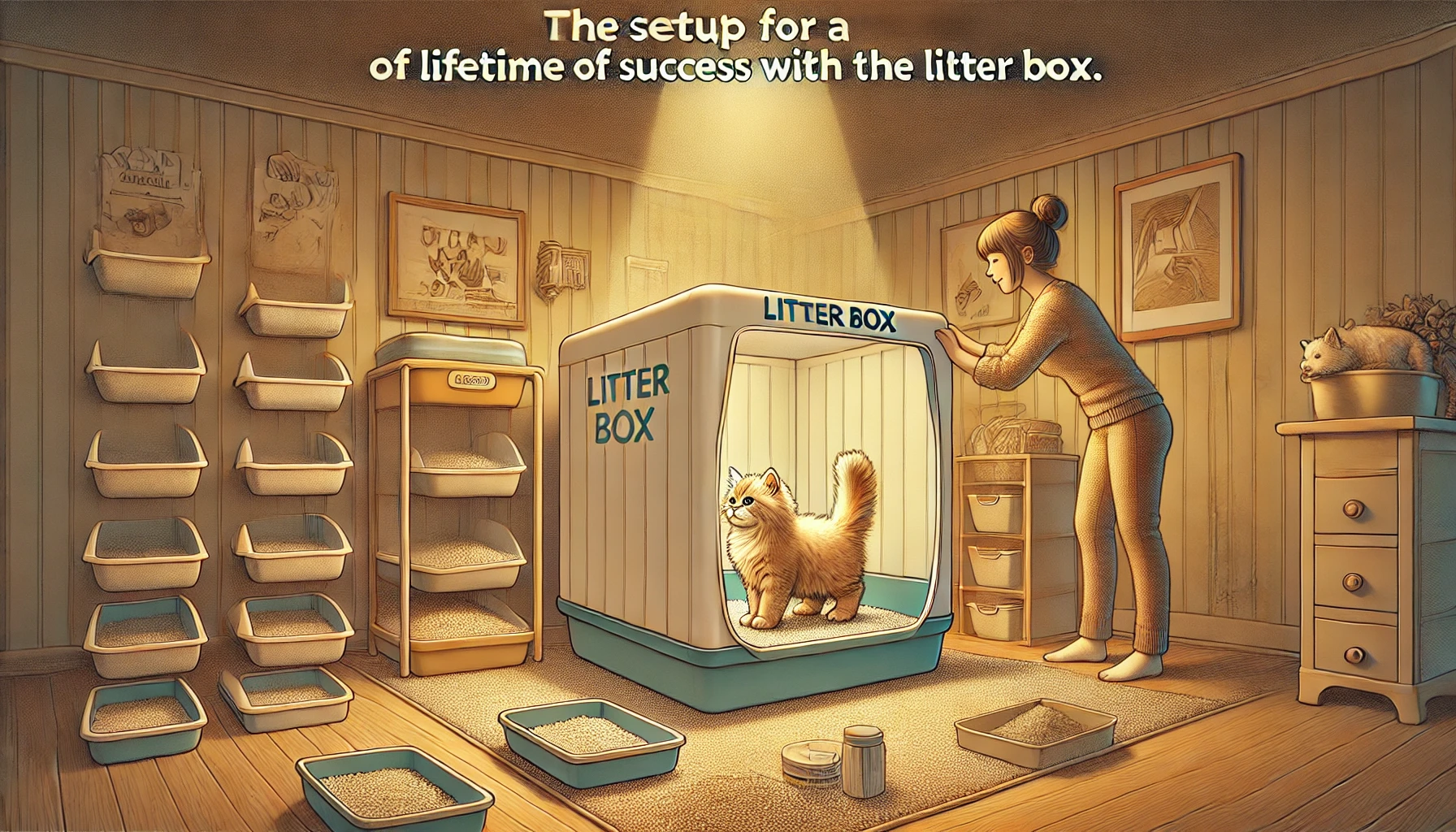
Setting It Up Right for a Lifetime of Success with the Litter Box
Ultimately, litter training is key to ensuring that the interaction between you and your cat remains stress-free and hygienic.
By following the step-by-step procedures outlined in this article and observing what works best for your cat, you can establish litter box success that will endure throughout their life.
Remember that every cat is different, so be flexible and patient as you find the best approach for your cat’s unique personality and preferences.
When done correctly, your cat will enjoy a lifetime of healthy, positive litter box habits.

FAQs About Litter Training
We have compiled some common questions regarding litter training for your kitten.
These answers provide quick solutions to help make the process easier.
When should I start litter training my kitten?
It’s a good idea to start litter training as soon as you bring the kitten home, ideally when the kitten is 3-4 weeks old.
Early training instills good habits and makes transitions easier.
How frequently should I clean the litter box?
Scoop the litter box daily and change it completely once a week, or sooner if necessary, depending on the number of cats and the type of litter you use.
What type of cat litter should I use with my kitten?
Most recommend using non-clumping, dust-free litter for kittens, as it’s safer if accidentally ingested and gentler on sensitive paws.
You can switch to other litter types as your kitten grows older.
My kitten has accidents outside the box. What do I do?
Keep the litter box clean, in a quiet area, and easily accessible for your kitten.
If accidents persist, consider trying a new litter or box, and consult a veterinarian to rule out any health issues.
How do I transition my kitten onto new litter?
Gradually mix the new litter with the old for a few days.
Slowly increase the amount of new litter while reducing the old until your kitten fully adjusts to the new litter.
Why is my kitten scratching excessively in the litter box?
Excessive scratching may indicate that your kitten dislikes the litter or finds the box dirty.
Try switching to a different litter, cleaning the box more frequently, or using a larger box.
What if my kitten is fearful of the litter box?
If your kitten is anxious, create a calm environment and avoid scolding for accidents.
Gradually reintroduce the litter box, offer praise for successful use, and give your kitten time to adjust without pressure.



